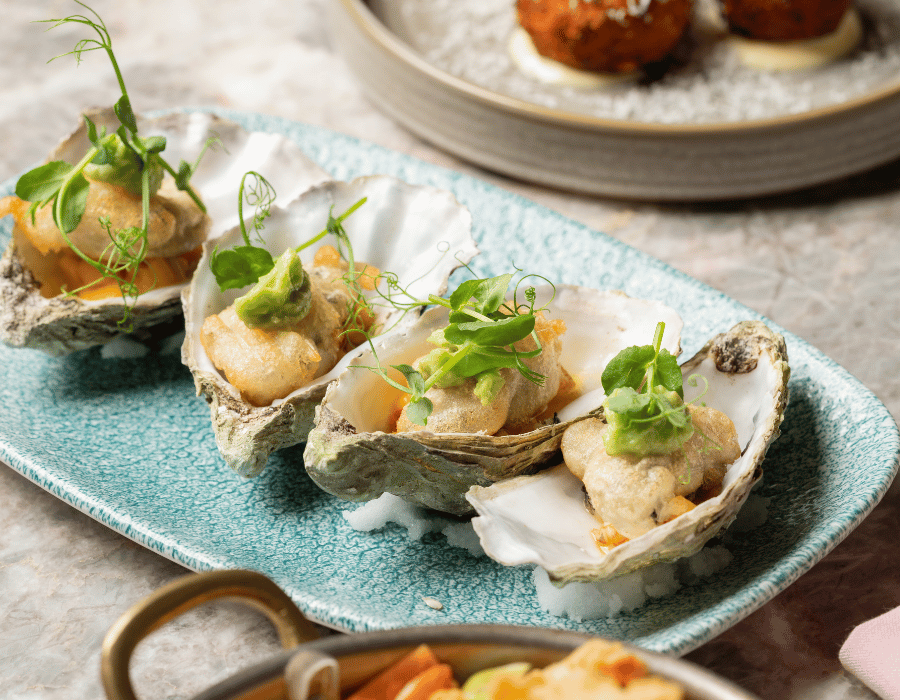Oysters: East Coast vs West Coast – What is the difference?
What is the difference?

Oysters have long been a delicacy enjoyed by seafood lovers around the world, and in the United States, two distinct varieties have emerged: West Coast and East Coast. Both delicious but with some differences.
East Coast oysters and West Coast oysters have their own unique characteristics that set them apart from one another in terms of taste, texture, and appearance and it is estimated that the United States produces a whopping two billion oysters each year roughly, with East Coast oysters accounting for a significant portion of that number. When it comes to enjoying oysters, they can be enjoyed raw, grilling, or frying them. Below we’re going to discuss the differences between East Coast and West Coast oysters and go into a little bit more detail on the different types, popular choices and their significant differences.

East Coast vs West Coast Oysters: Taste
East Coast and West Coast oysters are known for their unique tastes and textures, which are influenced by the regions they are grown in. Some of the key differences between the two are listed below:
Salinity: East Coast oysters tend to be saltier than their West Coast counterparts, due to the higher salt content in the waters where they are grown. This can give East Coast oysters a more briny, mineral-like flavour.
Flavour profile: East Coast oysters are known for their complex, layered flavours, which can include hints of seaweed, minerals, and sometimes a buttery taste. West Coast oysters, on the other hand, tend to have a more pronounced sweet and fruity flavour, with some foodies claiming to taste notes of melon, cucumber, and even citrus.
Texture: East Coast oysters are often described as firmer and chewier than West Coast oysters, which are generally softer and more delicate.
East Coast vs West Coast Oysters: Size
East Coast and West Coast oysters are known for their distinct differences in size and shape. Generally, East Coast oysters tend to be smaller and more elongated in shape, while West Coast oysters are usually larger and rounder.
East Coast oysters, which are typically harvested from the Atlantic Ocean and the Gulf of Mexico, are generally smaller in size, with an average length of about 2 to 3 inches. They are often referred to as “cocktail” or “petite” oysters, and are well-suited for raw consumption.
In contrast, West Coast oysters are harvested from the Pacific Ocean and tend to be larger and plumper than their East Coast counterparts, with an average length of 3 to 4 inches. They are often referred to as “full-bodied” or “meaty” oysters, and are popular for use in cooked dishes like stews and chowders.
East Coast vs West Coast Oysters: Shape
East Coast and West Coast oysters are known for their distinct differences in shape. Generally, East Coast oysters tend to be more elongated in shape, while West Coast oysters are rounder.
East Coast vs West Coast Oysters: Appearance
East Coast and West Coast oysters can differ in their appearance in several ways, including their shell colour, texture, and overall appearance.
East Coast oysters tend to have a rougher, more textured shell compared to West Coast oysters. The shells of East Coast oysters can range in colour from brown to grey to white, with some oysters featuring distinct banding or stripes.
West Coast oysters, on the other hand, tend to have a smoother, more polished-looking shell compared to East Coast oysters. The shells of West Coast oysters can range in colour from black to brown to white, and often have a more uniform, rounded shape.
East Coast vs West Coast Oysters: Origins
The terms “East Coast” and “West Coast” are used to describe oysters that are harvested from different coastal regions of the United States.
East Coast oysters are typically harvested from the Atlantic Ocean and the Gulf of Mexico, and are grown along the eastern seaboard from Maine to Florida. Some of the most popular varieties of East Coast oysters include Blue Point from Long Island, Wellfleet from Cape Cod, and Chincoteague from Virginia.
West Coast oysters are harvested from the Pacific Ocean, and are grown along the coast from Alaska to Baja California. Some of the most popular varieties of West Coast oysters include Kumamoto from Washington, Kusshi from British Columbia, and Pacific from California.
The differences in location can affect the taste, texture, and appearance of the oysters due to variations in the water temperature, salinity, and other environmental factors.

Types Of East Coast Oysters
Blue Point oysters are named for the town of Blue Point on Long Island, where they were first harvested in the 1800s. They have a mild brininess and a crisp, clean flavour, with a slightly sweet finish.
Wellfleet oysters are harvested from the waters off Cape Cod in Massachusetts. They have a full, meaty texture and a slightly sweet, buttery flavour.
Chincoteague oysters are grown in the waters surrounding Chincoteague Island in Virginia. They have a salty, briny flavour and a clean finish, with a slightly sweet aftertaste.
Malpeque oysters are harvested from the waters off Prince Edward Island in Canada, but are also considered an East Coast oyster. They have a salty, crisp flavour and a clean, briny finish.
Island Creek oysters are grown in the waters off Duxbury, Massachusetts. They have a full, meaty texture and a briny, slightly sweet flavour, with a clean finish.
Beau Soleil oysters are grown in the waters off New Brunswick in Canada, but are also considered an East Coast oyster. They have a smooth, silky texture and a sweet, slightly nutty flavour, with a clean finish.
Cape May Salt oysters are harvested from the waters off Cape May in New Jersey. They have a mild, briny flavour and a clean, crisp finish, with a slightly sweet aftertaste.

Types Of West Coast Oysters
Kumamoto oysters are grown in the waters off the Pacific Northwest, particularly in Washington and Oregon. They have a small, deep-cupped shell and a sweet, delicate flavour with a hint of melon and cucumber.
Pacific oysters are the most commonly grown oysters in the United States, and are grown in waters ranging from Alaska to Mexico. They have a briny flavour with a crisp, clean finish, and are often quite meaty.
Kusshi oysters are grown in British Columbia and have a deep, bowl-like shape. They have a sweet, creamy flavour with a mild brininess and a buttery finish.
Miyagi oysters are grown in the waters off Washington and British Columbia. They have a sweet, mild flavour with a buttery finish and a slightly crisp texture.
Fanny Bay oysters are grown in the waters off Vancouver Island in British Columbia. They have a firm, meaty texture and a briny, slightly sweet flavour with a crisp finish.
Hama Hama oysters are grown in the waters off the Olympic Peninsula in Washington. They have a rich, buttery flavour with a briny finish and a firm, chewy texture.
Totten Inlet oysters are grown in the waters off the Puget Sound in Washington. They have a crisp, briny flavour with a slightly sweet finish and a firm, meaty texture.
East Coast and West Coast oysters are both prized for their unique taste, texture, and appearance. While East Coast oysters are generally larger and are considered to have a milder flavour, West Coast oysters are often smaller and boast a more complex taste. Whether you are a seasoned oyster lover or a first-time taster, East Coast and West Coast oysters are sure to become a firm favourite menu item and a treat for your next dinner out.



